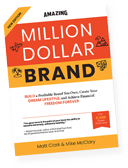Alexandra: How I Got Over $6000 in Funding with Kickstarter
Crowdfunding is the hottest new way to fund your startup. One of our very own students launched a Kickstarter campaign and reached her goal! She shared her story with us: the successes, the challenges, and everything in between.
Alexandra, an Amazing Selling Machine member who joined in April 2014, has two private label products live on Amazon. She decided to test the Kickstarter waters to fund and launch her third and newest product. Before the 2015 Live Event, Alexandra hadn?t even heard of Kickstarter. At the Live Event, she watched a presentation by John Galley on using Kickstarter to fund and launch a product, and she knew she had to try it.
There is risk involved with Kickstarter: it?s all or nothing, depending on whether or not you hit your funding goal. The end of Alexandra?s 34-day campaign is only days away and she has already surpassed her goal! Here are some of the lessons that Alexandra learned from researching and running her Kickstarter campaign:
1. Build up your social media presence before you launch
Having a social media presence is extremely important before launching a Kickstarter. It adds legitimacy to your brand and product. It also gives social proof to anyone you are trying to pitch that the brand can be trusted.
“I found this out about three weeks before I was ready to launch. I launched and then started scrambling on the social media part of it, and it was really tough!”
2. Have a list of people ready to fund right away.
“I?ve heard it said that you need to have at least 100 people ready to go the moment you launch in order to hit that algorithm in Kickstarter. I had that, but people thought it was better to contribute periodically throughout the campaign. You need to make this clear.We did start out slow, which is one of the big things you are not supposed to do.”
3. Launch on a Tuesday at 8:00am Pacific Standard Time.
Alexandra’s research has shown that Tuesday’s are the best day to launch your campaign.
“That’s when I did it. In fact, within five minutes, we had our first backer, and I’d never heard of him. That was kind of cool!”
4. End your campaign on a Sunday night.
“In my research I heard that Friday nights and Saturday nights are when the most funding happens.”
Because of this, you want to be sure your campaign ends on a Sunday so that you are catching the most traffic before it ends.
5. Find a champion.
“This means find somebody who’s going to just naturally be so excited about your product they will do anything they can to get it out there and make it happen. Their reach will help you do that. Find a champion, someone who will promote it as much as possible.”
6. Factor shipping costs into price (and Kickstarter’s fees).
“What I?ve heard one person, who has backed around 200 campaigns, say is that it upsets him when the rewards look affordable and then he finds out that the shipping makes the price much higher. Make sure that the shipping is up-front. Tell your backers how much it’s going to be so that they don’t get blind-sided when they receive the reward. Part of that is that the shipping is actually included in your funding amount.”
Also, don’t forget that Kickstarter does take a percentage of your funding as fees!
7. Make your campaign last around 30 days.
“Kickstarter recommends 30 days or less. Some people who created campaigns said they wished they had done it longer. They wanted to do it longer so that they?ll get more funding, but the downside is you can lose momentum. Those last minute people at the end who want to fund might forget about it and they’re not going to come back.”
8. Use Kickstarter as an experiment
For any entrepreneur attempting to launch a new product or business, Kickstarter can be a great indication of how your product will do once it hits the market.
“That’s one of the reasons why I did it in the first place. I thought this is a great way to find out whether there’s demand.”
9. It’s okay to make mistakes.
“You can create your campaign page and you can edit it all throughout until the moment you launch. Even then, you can edit your page throughout the launch. Don’t be afraid to just throw things up there and come back to it later, because you can.”
With Kickstarter campaigns, the only two things set in stone are your funding goal and your campaign end-date. Keep in mind your rewards can only be changed BEFORE someone has pledged that particular reward. Then it’s set in stone.
“You can still ADD rewards anytime throughout the campaign, such as if you get feedback that people want something other than what you’re offering.”
10. Be concise with your rewards.
Any copywriter will tell you how important word choice is. Make every word count in your reward box! You don’t want funders to have to search and scroll for your rewards.
“Keep the text in each reward box fairly short, because the longer it gets, the harder it is to read, and the more confused people get.”
Find your first--or next--product to sell fast
Discover top-selling products on Amazon. See accurate sales trends and profit estimates so your next product succeeds. Plus, plan out your entire product and brand with a new custom AI tool unavailable anywhere else.
Heading 1
with a request body that specifies how to map the columns of your import file to the associated CRM properties in HubSpot.... In the request JSON, define the import file details, including mapping the spreadsheet's columns to HubSpot data. Your request JSON should include the following fields:... entry for each column.


